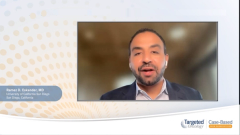
HPV and Cervical Cancer: Prevention and Screening Strategies
Expert insight into the pivotal role of HPV vaccines, evolving vaccination strategies, and advanced screening methods in cervical cancer prevention and management on a global scale.
Episodes in this series

Transcript:
Ramez N. Eskander, MD: Cervical carcinoma is one of the malignancies that we have an opportunity to truly understand and…define the causative agent. For many malignancies, there are various risk factors that are not yet quite well-defined. But for cervical carcinoma, we understand that nearly all cervical cancers are HPV [human papillomavirus] driven, and that was the impetus behind the development of HPV-based therapeutic vaccines. In this particular instance, we understand that cervical cancer is an HPV-related and HPV-driven malignancy.
And we also understand that this has given us an opportunity to develop preventive measures—as I alluded to, vaccine-based strategies—but it has also helped inform therapeutic treatment opportunities based on the biologic underpinnings of the carcinoma. Although we have vaccines that are effective, we also understand that cervical cancer continues to be a disease with a global burden, where it impacts developing nations much more than developed nations and highlights the importance of trying to identify therapeutic treatment opportunities as well as educate regarding prevention strategies on a [broader] level.
Thankfully, we have entered an arena where our identification of HPV vaccines and our knowledge of the therapeutic efficacy in preventing pathology have really transformed the way that we try to prevent HPV-related…precancer and cancerous lesions. We have gone through an evolution from bivalent to quadrivalent to 9-valent HPV vaccination strategies. We’ve understood that it is most effective when you vaccinate before HPV exposure. But I will also, in the same breath, that we’ve also had an expansion of the indication so that we can vaccinate individuals at later stages in life. Before, HPV…vaccination was limited to an earlier age of 9 to 25 [years]. For example, now it goes well beyond age 25 as a vaccination strategy because we understand that it can still benefit these patients, even after prior exposure, [and protect them from] strains to which they were not yet exposed.
By incorporating HPV vaccination as an opportunity for cancer prevention, we can see a reduction in the burden of this disease. And that’s the goal, to see this globally. But of course, the implementation of HPV vaccination on a global level and the uptake of HPV vaccination have to be much greater. Although we have made progress, it is clear that we have to continue to [share] the importance of vaccination as a prevention strategy so that the uptake of vaccine acceptance rates across adolescents and young adults continues to rise. Ultimately, that’s what’s going to translate into improved prevention and a reduction in cervical cancer–based mortality. As an example, here in the United States, we have [approximately] 12,000 new cancer cases [each year]. Globally, it’s multiple-folds greater than that, [more than] half a million. So you’re talking about a very dramatic difference. We have [approximately] 3000 to 4000 deaths per year in the United States, which again highlights the progress that we’ve made. But also, in the same breath, it makes us very conscious about the opportunities that we have to improve outcomes on a global level.
Screening for cervical cancer has actually come a long way from our identification of the relevance of the [Papanicolaou test]. We’ve also come to incorporate high-risk HPV testing, and there has been an evolution of which components are important. Do we do this as sequential therapy, do we do it as concurrent testing, or do we substitute? Right now, we do concurrent testing with cytology [for patients with] high-risk HPV. Although, importantly, the incorporation of high-risk HPV testing on its own has also been advised as a potential screening opportunity. ontesting is unremarkable, meaning cytology and HPV are negative, then you can defer subsequent screening for 5 years and then repeat testing….When I, as a gynecological oncologist, take care of patients who come to me with cervical cancer, there’s always concern about spacing out screening studies. But again, it’s important to recognize that screening strategies are developed…on population-based metrics. And that is critical because when we take care of patients, we’re looking at an individual person, their risk factors, and what might impact management and screening for that patient independent of screening guidelines as a whole. Again, you can do independent, high-risk HPV assessments on their own. And if [the results are] negative, of course, subsequent screening with high-risk HPV assessment at appropriate intervals of 3 to 5 years, and then triage to interventions as indicated.
Transcript is AI generated and edited for readability.










































